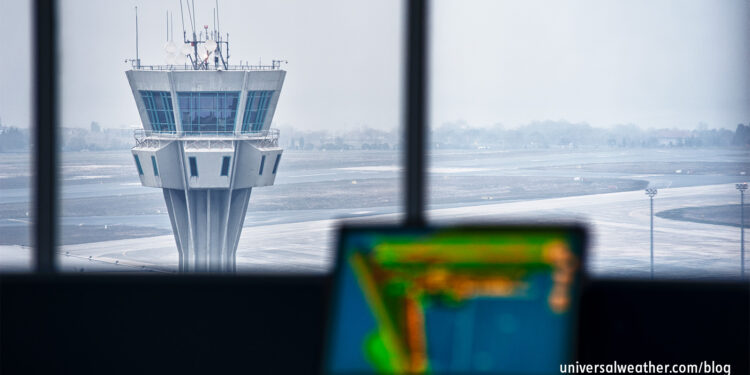FAA’s Data Comm Program: Overview and Effects for Operators

The Federal Aviation Administration’s (FAA’s) Data Comm program will change how operators receive flight plans and, to a certain extent, the manner in which flight plans are uplinked. It’s important to be aware of these changes as they went into effect as of June 2015.
The following is an overview of what you need to know:
1. New program basics
The Data Comm program uses a combination of Controller Pilot Data Link Communications (CPDLC) and pre-departure clearance (PDC) technology to enhance communications between the flight deck and air traffic control. It’s part of a baseline for other technologies that will be implemented in the future. These Data Comm changes cover items such as clearances, instructions, flight crew requests/reports, and even traffic flow management.
2. Program objectives
The Data Comm program is the first phase of NextGEN and is a part of other traffic management improvements the FAA plans to implement downline. The objective is to improve safety, reduce traffic delays throughout the system, and maximize fuel savings by decreasing departure/arrival delays.
3. Implementation and timeline
The first phase went into effect in June 2015, at certain U.S. airports. This will eventually be rolled out nationwide in different stages. Segment one of phase one covers tower communication services. This will be followed by segment one of phase two which encompasses enroute and advanced services. Note that phase one changes will not impact general aviation but only apply to scheduled commercial airlines on a voluntary basis. Operators participating in this trial phase must ensure proper coding for International Civil Aviation Organization (ICAO) sections of their flight plans. More information can be found on the FAA’s website for Data Comm Implementation Team (DCIT).
4. DCL considerations
Departure clearances (DCLs) will be a method to uplink clearances when a flight plan does not match the flight plan on your flight management system. You’ll be able to accept, reject, or standby the flight plan as needed.
5. DCL requirements
To use DCL services, both the FAA and users need to meet certain ICAO flight plan requirements. FAA will support initial and amendment flight plan filings based on ICAO 2012 flight plan requirements. Users must file ICAO 4444 flight plans – essentially an ICAO 2012 flight plan – to use CPDLC DCL services. Operators must indicate, 45-60 minutes prior to departure, if they’ll use PDC or CPDLC DCL.
6. CPDLC requirements
Operators must be CPDLC-equipped to use Data Comm. If you do not have CPDLC, you may use PDC for the time being. Be mindful that when this program is complete (currently estimated at the end of 2016), all aircraft operating in U.S. airspace will need to be CPDLC-equipped to use Data Comm.
7. Flight plan requirements
Your ICAO flight plan must be filled out as follows:
- Aircraft identification
- Field 7a (where the tail number or call sign will be placed)
- Aircraft equipage capabilities
- Field 10a (such as MNPS, RVSM, HF, datalink, CPDLC, FANS, etc.)
- Other information
- Aircraft registration number
- Field 18 REG/(is where the actual aircraft registry will be placed)
- Used if Field 7a is not the aircraft registration number (if 7a is the call sign and not the registration number)
- This item is required for CPDLC DCL service
- Field 18 REG/(is where the actual aircraft registry will be placed)
- Aircraft registration number
- Preference for clearance delivery mechanism
- Field 18 DAT/(this is the type of datalink the aircraft has)
- To indicate the operator’s preference for PDC or CPDLC DCL
- Field 18 DAT/(this is the type of datalink the aircraft has)
8. Additional flight plan notations
Note that you must indicate the following additional information in the ICAO section of your flight plan to indicate CDPLC DCL or PDC clearance. Bold areas below are items that affect clearance type:
- Field 10a – E-codes (E1-E3)
- E1 FMC WPR
- E2 D-FIS
- E3 PDC
- Field 10a – J-codes [CPDLC ATN]
- J1 VDL Mode 2 (ATN)
- Field 10a – J-codes [CPDLC FANS 1/A]
- J2 HFDL
- J3 VDL Mode 4
- J4 VDL Mode 2 (FANS 1/A)
- J5 Satellite Inmarsat
- J6 Satellite MTSAT
- J7 Satellite Iridium
- Field 10a – P-codes (P1-P9)
- For RCP
- Are not defined, are labeled as “Reserved”
- Field 18
- REG/– has aircraft registration – tail number (if the item placed in 7a is not the tail number)
- DAT/– for data applications
For information on coding, you can visit Eurocontrol’s interactive guide for ICAO 2012 coding.
9. Equipment requirements
While this program does not initially require aircraft to have specific equipment, onboard avionics will need to be Future Air Navigation System (FANS) and Baseline 2 with Aeronautical Telecommunications Network (ATN). Also, your aircraft must have VHF, for communications within the continental U.S., and Satcom, for oceanic area communications.
10. Third-party provider assistance
Once the program is fully implemented, 3rd-party providers will be able to fully assist with operator flight plans.
11. Additional information
For more insight into the Data Comm Program initiative, see the FAA DCIT site. Additionally, your 3rd-party provider can offer in-depth information on this program, as well as updates on how the program progresses.
Conclusion
By the end of 2016 – assuming no delays take place – all aircraft operating in U.S. airspace must be CPDLC-equipped in order to participate in FAA’s Data Comm program. Operators without CPDLC certifications will likely receive lower priority in regards to clearances.
Questions?
If you have any questions about this article or would like flight planning assistance, contact me at markmiller@univ-wea.com.




